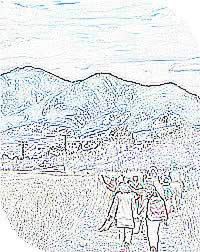Educational Portfolio for Spencer Olmsted
Contact Information
Spencer Olmsted513 Central St NE
Olympia, WA 98506
(solmsted at yahoo)
2009-Current: 5th grade math and science teacher at Pioneer Elementary School in Olympia, Washington.
2006-2009: 5th grade teacher at L.P. Brown in Olympia.
Fall 2005: student taught in the 4th grade at Morning Star Elementary School in Bozeman, Montana.
Education
Links place content further down the page.Blog Entries
Graduate Work

Field trip to the Tinsley House at the Museum of the Rockies
The Social Constructivist Learning Process
The brain is a learning machine. Our brain sees the world around us through our senses. This concrete experience starts the learning cycle. Inside the various centers of the brain in charge of dealing with different sensory input, neuronal networks (networks of connected neurons) are being stimulated. Electrical impulses travel from dendrites through axons to the axon terminals and convert to chemical neurotransmitters (e.g. serotonin) to cross the synaptic gap (the area around the gap and the gap between neurons) to the next neuron. This process takes place constantly and is happening in many areas of our brain simultaneously. The effort is our attempt to construct meaning from our experience. If we find a matching network for the input, our mind is in a state of equilibrium: a kind of balance. In this case a process called myelination takes place which is the addition of fat around the axons of the neurons in a network. This insulates and speeds up future transmissions along this route. Additional neurotransmitters or transmitter receivers can also be added or removed to increase the synaptic efficiency in this network. Our brain is thinking that this network is valuable, so it strengthens it. On the other hand, if the experience does not find a match, we find ourselves in a state of disequilibrium, or imbalance. At this point we go through what Piaget calls the process of adaptation. To adapt our current network, we can either assimilate the information into an existing network, or accommodate it by building new neuronal networks. Either process will bring us back into equilibrium: we have made some degree of sense of this new information, and put it into its place. The way in which we store related information, our "theory of the world" as Piaget called it, is called our schema.
But biology is not the only way to examine the learning process. Vygotsky, who was a social psychologist working at the same time as Piaget, looked at things through the lens of environmental factors that influence learning. His way of talking about the process of adaptation is through social communication; he called it the dialectical process. We put ideas out into the world and receive feedback from our environment. Vygotsky uses the term 'intramental ' to describe our existing schemas. In this area we are limited to our own experiences. Each person has a range of possible development that can take place in a given area at a given time. This is our ability to grasp new concepts. Vygotsky calls this the zone of proximal development. We can always do more with assistance than on our own, which is why social learning is so important. When we work with others we are working between minds. He called this space 'intermental'. In these situations there will always be a more capable peer in the group who can offer form of scaffolding, or helping others reach their potential. The 'more capable peer' could be a person, but it doesn't have to be. The necessary piece is communication of meaning through language in its broadest sense. Through this dialectical process, perhaps with some scaffolding, we internalize new concepts. This is akin to adaptation. Both Piaget and Vygotsky support the idea that the learner constructs their own knowledge. Learning is fundamentally a physical process, but there are many psychological factors that help shape it.